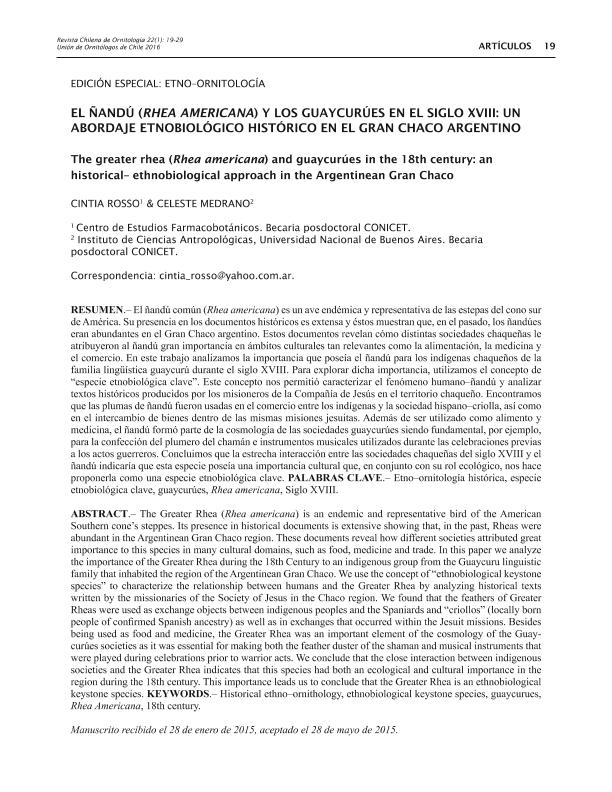Mostrar el registro sencillo del ítem
dc.contributor.author
Rosso, Cintia Natalia

dc.contributor.author
Medrano, María Celeste

dc.date.available
2018-05-31T18:28:31Z
dc.date.issued
2016-03
dc.identifier.citation
Rosso, Cintia Natalia; Medrano, María Celeste; El ñandú (Rhea americana) y los guaycurúes en el siglo XVIII: un abordaje etnobiológico histórico en el Gran Chaco argentino; Unión de Ornitólogos de Chile; Revista Chilena de Ornitología; 22; 1; 3-2016; 19-29
dc.identifier.issn
0717-1897
dc.identifier.uri
http://hdl.handle.net/11336/46850
dc.description.abstract
El ñandú (Rhea americana) es un ave endémica del territorio sudamericano. Su aparición en los documentos históricos es extensa y muestra que se encontraba en abundancia en la antigüedad. Por ello, distintas sociedades le han atribuido gran importancia en distintos ámbitos culturales como la alimentación, medicina y comercio. En este trabajo analizamos la importancia que poseía el ñandú para los indígenas de la familia lingüística guaycurú que habitaban la región del Gran Chaco argentino en el siglo XVIII. Para ello utilizamos el concepto de ?especies etnobiológicas claves?. Esta categoría nos permitió un acercamiento al fenómeno humano-ñandú, analizando textos históricos producidos por los misioneros de la Compañía de Jesús en el territorio chaqueño. Encontramos que las plumas de ñandú fueron usadas en el comercio con la sociedad hispano-criolla así como en los intercambios que se producían dentro de las misiones jesuitas. Esta especie además de ser utilizada como alimento y medicina formaba parte importante de la cosmología de las sociedades guaycurúes siendo fundamental para confeccionar el plumero del chamán e instrumentos musicales tocados durante las celebraciones previas a los actos guerreros. Concluimos que a las interacciones entre humanos y animales es necesario comprenderlas transitando el eje temporal que permita dar cuenta del devenir histórico en el cual las sociedades y sus entornos están inmersos.
dc.description.abstract
The Greater Rhea (Rhea americana) is an endemic and representative bird of the American Southern cone’s steppes. Its presence in historical documents is extensive showing that, in the past, Rheas were abundant in the Argentinean Gran Chaco region. These documents reveal how different societies attributed great importance to this species in many cultural domains, such as food, medicine and trade. In this paper we analyze the importance of the Greater Rhea during the 18th Century to an indigenous group from the Guaycuru linguistic family that inhabited the region of the Argentinean Gran Chaco. We use the concept of “ethnobiological keystone species” to characterize the relationship between humans and the Greater Rhea by analyzing historical texts written by the missionaries of the Society of Jesus in the Chaco region. We found that the feathers of Greater Rheas were used as exchange objects between indigenous peoples and the Spaniards and “criollos” (locally born people of confirmed Spanish ancestry) as well as in exchanges that occurred within the Jesuit missions. Besides being used as food and medicine, the Greater Rhea was an important element of the cosmology of the Guaycurúes societies as it was essential for making both the feather duster of the shaman and musical instruments that were played during celebrations prior to warrior acts. We conclude that the close interaction between indigenous societies and the Greater Rhea indicates that this species had both an ecological and cultural importance in the region during the 18th century. This importance leads us to conclude that the Greater Rhea is an ethnobiological keystone species.
dc.format
application/pdf
dc.language.iso
spa
dc.publisher
Unión de Ornitólogos de Chile
dc.rights
info:eu-repo/semantics/openAccess
dc.rights.uri
https://creativecommons.org/licenses/by-nc-sa/2.5/ar/
dc.subject
Etno-Ornitología Histórica
dc.subject
Especie Etnobiológica Clave
dc.subject
Guaycurúes
dc.subject
Rhea Americana
dc.subject.classification
Zoología, Ornitología, Entomología, Etología

dc.subject.classification
Ciencias Biológicas

dc.subject.classification
CIENCIAS NATURALES Y EXACTAS

dc.title
El ñandú (Rhea americana) y los guaycurúes en el siglo XVIII: un abordaje etnobiológico histórico en el Gran Chaco argentino
dc.title
The greater rhea (Rhea americana) and guaycurúes in the 18th century: an historical- ethnobiological approach in the Argentinean Gran Chaco
dc.type
info:eu-repo/semantics/article
dc.type
info:ar-repo/semantics/artículo
dc.type
info:eu-repo/semantics/publishedVersion
dc.date.updated
2018-05-24T14:31:02Z
dc.journal.volume
22
dc.journal.number
1
dc.journal.pagination
19-29
dc.journal.pais
Chile

dc.journal.ciudad
Santigo de Chile
dc.description.fil
Fil: Rosso, Cintia Natalia. Consejo Nacional de Investigaciones Científicas y Técnicas. Oficina de Coordinación Administrativa Parque Centenario. Museo Argentino de Ciencias Naturales "Bernardino Rivadavia"; Argentina
dc.description.fil
Fil: Medrano, María Celeste. Universidad de Buenos Aires. Facultad de Filosofía y Letras. Instituto de Ciencias Antropológicas; Argentina. Consejo Nacional de Investigaciones Científicas y Técnicas; Argentina
dc.journal.title
Revista Chilena de Ornitología
dc.relation.alternativeid
info:eu-repo/semantics/altIdentifier/url/http://www.aveschile.cl/wp-content/uploads/2018/04/3.-El-%C3%B1and%C3%BA-y-los-guaycur%C3%BAes_Rosso-Medrano.pdf
Archivos asociados
